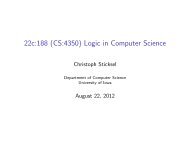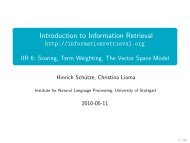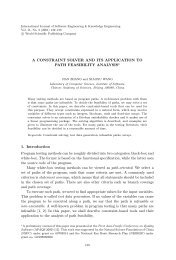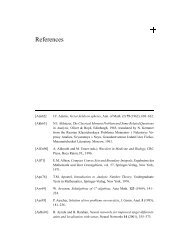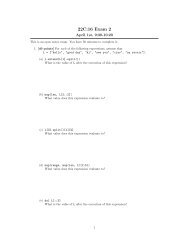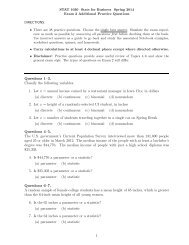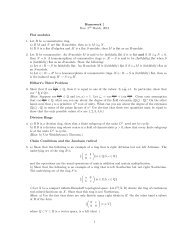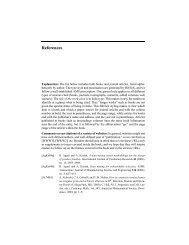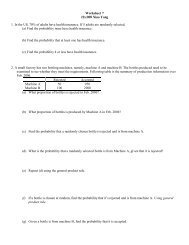Stat 1030 Spring 2013 Final Exam Information and In-Class Final ...
Stat 1030 Spring 2013 Final Exam Information and In-Class Final ...
Stat 1030 Spring 2013 Final Exam Information and In-Class Final ...
You also want an ePaper? Increase the reach of your titles
YUMPU automatically turns print PDFs into web optimized ePapers that Google loves.
<strong>Stat</strong> <strong>1030</strong> <strong>Spring</strong> <strong>2013</strong><br />
<strong>Final</strong> <strong>Exam</strong> <strong><strong>In</strong>formation</strong> <strong>and</strong> <strong>In</strong>-<strong>Class</strong> <strong>Final</strong> <strong>Exam</strong> Review Questions<br />
• <strong>Exam</strong> Time: 12:30–2:30 PM Friday, May 17<br />
• <strong>Exam</strong> Locations:<br />
Location<br />
W128 CB<br />
Sections<br />
SCA, SCB<br />
W290 CB A 3 –A 9<br />
AUD MH<br />
A 10 –A 20 , SCC, SCD<br />
<strong>Final</strong> <strong>Exam</strong> <strong><strong>In</strong>formation</strong><br />
• <strong>Exam</strong> Materials: Calculator (no cell phones), pencils, <strong>and</strong> four 8 1 ′′<br />
2 × 11<br />
′′<br />
sheets of paper,<br />
front <strong>and</strong> back.<br />
• <strong>Exam</strong> Procedure:<br />
When finished, place the bubble sheet inside the first page of the exam booklet.<br />
You must show your UI student ID to a TA to receive grading credit for<br />
the exam.<br />
• <strong>Exam</strong> Content:<br />
* 50 multiple choice questions related to ideas from Topic Notes, Homework, Quizzes,<br />
Discussion Worksheets, <strong>and</strong> MINITAB Reports. Each question is worth 1.65 points (plus<br />
a base score of 17.5 points.)<br />
* Roughly a quarter of exam questions cover new material since <strong>Exam</strong> 3 (Topic 9–10)<br />
while the remainder cover review material (Topics 1–8.)<br />
• Review Week Schedule:<br />
* Monday<br />
◦ Finish Notebook 4 (<strong>Exam</strong>ple 5: Political Science <strong>Class</strong>)<br />
◦ <strong>In</strong>-<strong>Class</strong> <strong>Final</strong> <strong>Exam</strong> Review Questions. Check answers with TAs <strong>and</strong> Prof. Whitten.<br />
◦ Whitten’s Monday evening office hours MOVED from 5:00-6:30 to 8:00-9:30 PM.<br />
* Tuesday – Turn in MINITAB Report 2. Take Quiz 11 (special open book/notes format)<br />
* Wednesday – Q/A session with Prof. Whitten <strong>and</strong> TAs in Macbride<br />
* Thursday – Prep for <strong>Final</strong> <strong>Exam</strong> with TA<br />
• <strong>Exam</strong> Study Tips:<br />
* Study new material (Topics 9–10) from Notebook 4, HW 11-12, Worksheets, Quizzes,<br />
MINITAB Report 2.<br />
* Study review material (Topics 1–8) from <strong>In</strong>-<strong>Class</strong> <strong>Final</strong> <strong>Exam</strong> Review Questions,<br />
Additional <strong>Final</strong> <strong>Exam</strong> Review Questions (Parts 1 <strong>and</strong> 2) (available online),<br />
<strong>Exam</strong>s 1, 2, 3 <strong>and</strong> Topic 1–8 Notes, Homework, Worksheets, Quizzes, MINITAB Report 1.<br />
1
<strong>In</strong>-<strong>Class</strong> <strong>Final</strong> <strong>Exam</strong> Review Questions<br />
Disclaimer <strong>and</strong> Directions: These practice questions are intended to familiarize you with the<br />
style of the final exam. The content of actual final exam questions will differ. The exam format is<br />
multiple choice. Choose the single best answer for each question.<br />
Questions 1–2.<br />
<strong>Class</strong>ify the following r<strong>and</strong>om variables as either discrete or continuous.<br />
1. The time required for an email to travel through the <strong>In</strong>ternet from its point of origin to its<br />
destination, in seconds.<br />
(a) discrete<br />
(b) continuous<br />
2. The number of companies listed on the New York Stock Exchange whose stock increased in<br />
value between Jan. 1, 2012 <strong>and</strong> March 1, 2012.<br />
(a) discrete<br />
(b) continuous<br />
Question 3.<br />
A buyer for a lumber company must decide whether to buy a piece of l<strong>and</strong> containing 5000 pine<br />
trees. If 1000 of the trees are at least 40 feet tall, the buyer will purchase the l<strong>and</strong>, otherwise not.<br />
The owner of the l<strong>and</strong> reports that the trees average 30 feet in height, with a st<strong>and</strong>ard deviation<br />
of 3 feet. It is also known that tree heights form a bell-shaped distribution.<br />
3. Based on this information, what is the buyer’s decision?<br />
(a) Purchase the l<strong>and</strong> since approximately 20% of the trees are at least 40 feet tall.<br />
(b) Do not purchase the l<strong>and</strong> since approximately 500 of the trees are at least 40 feet tall.<br />
(c) Do not purchase the l<strong>and</strong> since approximately 0% of the trees are at least 40 feet tall.<br />
(d) Do not purchase the l<strong>and</strong> since approximately 68% of the trees are between 27 <strong>and</strong> 33<br />
feet tall.<br />
(e) Purchase the l<strong>and</strong> since approximately 95% of the trees are between 40 <strong>and</strong> 46 feet tall.<br />
Questions 4–8.<br />
Henry Jordan is an accountant who works for the Toys R Us toy retailer corporation. Mr. Jordan<br />
works at a regional corporate office located in Atlanta, Georgia. On Dec. 30, 2011, Mr. Jordan<br />
was called into the office of his supervisor, Ms. Pamela White. Ms. White gave the following<br />
instructions to Mr. Jordan:<br />
“Listen, Henry. A tax specialist hired by Toys R Us management has found a new tax break<br />
in the tax code which may enable Toys R Us to reduce the amount it pays in 2011 corporate<br />
taxes by $2,500,000.<br />
“But in order to use this tax break, Toys R Us needs to know the Total Retail Value of<br />
<strong>In</strong>ventory (the total dollar value of all toy products in stock at retail prices) at each of our<br />
retail locations scattered around the country on the precise date of Dec. 31, 2011.<br />
“Unfortunately, the inventory computer program at one particular retail location in Denver,<br />
Colorado has crashed, so we have no idea what the TRVI is at that location.<br />
“Your job is to fly to the Denver location <strong>and</strong> calculate the TRVI on Dec. 31, 2011. This<br />
is important, because without that information, Toys R Us will not be able to use the tax<br />
break. Take a calculator with you, because you will need to manually add up the retail<br />
prices of all toy products in stock at the location to obtain the TRVI.”<br />
2
So, Jordan rushed off to the Atlanta airport to try to catch a flight to Denver. Unfortunately, icy<br />
weather resulted in the cancellation of all flights from Atlanta on Dec. 30 <strong>and</strong> on Dec. 31, 2011.<br />
On Jan. 1, 2012, Jordan called White from the Atlanta airport. “I’m sorry, Pam,” he said, “I was<br />
not able to get to Denver by Dec. 31. <strong>In</strong> fact, I’ve been stuck here at the Atlanta airport for two<br />
days.”<br />
White answered,“That’s okay, Henry. Nice try. I will inform Toys R Us management that we<br />
have no information about the TRVI at the Denver location on Dec. 31, 2011, <strong>and</strong> therefore, that<br />
Toys R Us cannot use the tax break for 2011 taxes.”<br />
Consider the Six Steps of <strong>In</strong>ference as they apply to the question of determining the TRVI at<br />
the Denver retail location on Dec. 31, 2011.<br />
4. Identify the population.<br />
(a) All toy products at all Toys R Us retail locations on Dec. 31, 2011.<br />
(b) All toy products in stock at the Denver location on Dec. 31, 2011.<br />
(c) The retail prices of all toy products at all Toys R Us retail locations on Dec. 31, 2011.<br />
(d) All Toys R Us retail locations on Dec. 31, 2011.<br />
(e) All toy products in stock at the Denver location during 2011.<br />
5. Identify the sample.<br />
(a) There is no sample.<br />
(b) All toy products in stock at the Denver location on Dec. 31, 2011 that Henry Jordan<br />
would have examined had he been able to fly to Denver.<br />
(c) The Denver location on Dec. 31, 2011.<br />
(d) The retail prices of all toy products at the Denver location on Dec. 31, 2011.<br />
(e) All toy products in stock at the Denver location on Dec. 31, 2011.<br />
6. What variable did Pamela White wish to measure on each unit in the population?<br />
(a) The TRVI at the Denver location on Dec. 31, 2011.<br />
(b) The retail price of a toy product.<br />
(c) A “Yes” or “No” answer as to whether Toys R Us can use the tax break for 2011 taxes.<br />
(d) The amount of tax reduction in 2011 for Toys R Us.<br />
(e) A “Yes” or “No” answer as to whether Henry Jordan is able to fly to Denver.<br />
7. What is the summary of the sample data?<br />
(a) There is no summary since there are no sample measurements.<br />
(b) The summary is exactly equal to the average TRVI on Dec. 31, 2011 at all Toys R Us<br />
locations other than the Denver location.<br />
(c) The TRVI at the Denver location on Dec. 31, 2011 can be estimated by the TRVI at<br />
the Denver location on Dec. 31, 2010.<br />
(d) The amount of tax reduction in 2011 for Toys R Us is exactly $0.<br />
(e) The answer is “No” as to whether Toys R Us receives a tax reduction in 2011.<br />
3
8. What is the inference?<br />
(a) The TRVI at the Denver location on Dec. 31, 2011 must be estimated from previous<br />
records.<br />
(b) There is no inference since there is no summary of sample data.<br />
(c) It’s time to go drink beer on the beach.<br />
(d) It’s time to fire Henry Jordan.<br />
(e) The TRVI at the Denver location on Dec. 31, 2011 is approximately equal to the average<br />
TRVI on Dec. 31, 2011 at all Toys R Us locations other than the Denver location.<br />
Questions 9–11.<br />
Three marbles are drawn at r<strong>and</strong>om <strong>and</strong> without replacement from a box which contains three red<br />
marbles <strong>and</strong> two blue marbles.<br />
9. What is the probability of drawing three red marbles?<br />
(a) 0 (b) 9/10 (c) 4/5 (d) 1 (e) None of the answers is correct.<br />
10. What is the probability of drawing two red marbles <strong>and</strong> one blue marble?<br />
(a) 1/10 (b) 3/10 (c) 7/10 (d) 3/5 (e) None of the answers is correct.<br />
11. What is the probability of drawing one red marble <strong>and</strong> two blue marbles?<br />
(a) 0 (b) 9/10 (c) 7/10 (d) 3/10 (e) None of the answers is correct.<br />
Questions 12–13.<br />
NASA’s space shuttles each have three on-board navigation computers, used by astronauts to safely<br />
return to earth from orbit. Any of the computers can, by itself, return the shuttle safely, assuming<br />
it is not malfunctioning. The three computers are designed to operate independently of each other,<br />
<strong>and</strong> the chance that any individual computer malfunctions during a single flight is 1%.<br />
12. What is the probability that a single shuttle flight returns safely to earth?<br />
(a) 0.01 % (b) 97.0 % (c) 99.99 % (d) 99 % (e) 99.9999 %<br />
13. If there are 12 shuttle flights scheduled for 2002, what is the probability that at least one of<br />
these flights will be unable to return to earth? (Assume that shuttle flights operate independently.)<br />
(a) 3.0 % (b) 0.0004 % (c) 11.9934 % (d) 0.0012 % (e) 99.9996 %<br />
Questions 14–16.<br />
The table below shows information from a review of the medical records of 587 Norwegians who<br />
experienced at least one heart attack. For each of these individuals, it was recorded whether or not<br />
the individual died within five years after the first heart attack <strong>and</strong> also whether the individual’s<br />
blood system contained low or high levels of an enzyme known as homocysteine. The objective of<br />
the medical review is to determine whether the level of homocysteine is related to risk of death<br />
within five years after a first heart attack among Norwegians.<br />
4
Death within 5 years Survival more than 5 years<br />
after first heart attack after first heart attack Total<br />
High homocysteine 138 85 223<br />
Low homocysteine 174 190 364<br />
Total 312 275 587<br />
14. What statistical population is associated with this medical review?<br />
(a) All Norwegians<br />
(b) All Norwegians who have experienced at least one heart attack<br />
(c) All Norwegians with potential heart problems<br />
(d) All human beings who have experienced at least one heart attack<br />
(e) All human beings with potential heart problems<br />
15. How many variables are measured in this study?<br />
(a) 0 (b) 1 (c) 2 (d) 3 (e) 4<br />
16. Based on the table, which of the following statements is true?<br />
(a) Death within five years after a first heart attack is independent of survival for more than<br />
five years after a first heart attack among Norwegians.<br />
(b) The level of homocysteine is independent of whether or not a Norwegian dies within five<br />
years after a first heart attack.<br />
(c) The probability of death within five years of a first heart attack is greater for Norwegians<br />
with low homocysteine than for Norwegians with high homocysteine.<br />
(d) The probability of death within five years of a first heart attack is greater for Norwegians<br />
with high homocysteine than for Norwegians with low homocysteine.<br />
(e) Among all Norwegians with high homocysteine <strong>and</strong> who also experience at least one<br />
heart attack, the probability of death within five years of a first heart attack is 47.8%.<br />
Questions 17–21.<br />
An elevator serving a hospital is designed to hold up to 15 passengers <strong>and</strong> has a maximum safe<br />
capacity of 2440 pounds. The weight of passengers who use the elevator is normally-distributed<br />
with an average of 149 pounds <strong>and</strong> a st<strong>and</strong>ard deviation of 20 pounds.<br />
17. What is the probability that a single passenger on the elevator weighs between 140 <strong>and</strong> 150<br />
pounds?<br />
(a) 0.1736 (b) 0.1537 (c) 0.2236 (d) 0.1935 (e) 0.1915<br />
18. What is the probability that a single passenger on the elevator weighs more than 200 pounds?<br />
(a) 0.9946 (b) 0.4946 (c) 0.0054 (d) 0.5054 (e) 0.9954<br />
19. If five passengers enter the elevator together, what is the probability that exactly four of them<br />
weigh 200 pounds or less?<br />
(a) 0.1512 (b) 0.000000004 (c) 0.9786 (d) 0.0264 (e) 0.1613<br />
5
20. If we consider only elevator trips which carry 8 passengers, how many of these passengers, on<br />
average, weigh 200 pounds or less?<br />
(a) 3.957 (b) 4.043 (c) 0.043 (d) 5.038 (e) 7.957<br />
21. What is the probability that the elevator’s safe capacity is exceeded by a full load of 15<br />
passengers?<br />
(a) 1.0 (b) 2.65 (c) 0.0040 (d) 0 (e) 0.0137<br />
Questions 22–26.<br />
<strong>In</strong> January of the year 2000, a Gallup poll asked a r<strong>and</strong>om sample of 1633 American adults, “<strong>In</strong><br />
general, are you satisfied or dissatisfied with the way things are going in the United <strong>Stat</strong>es?” <strong>In</strong><br />
the poll, 1127 said that they were satisfied.<br />
22. Describe the population parameter.<br />
(a) x = 1127 adult Americans who are satisfied in January 2000<br />
(b) p = proportion of all adult Americans who are satisfied in January 2000<br />
(c) ̂p = proportion of all adult Americans who are satisfied in January 2000<br />
(d) p = .6901<br />
(e) ̂p = .6901<br />
23. Provide the best estimate.<br />
(a) x = 1127 adult Americans who are satisfied in January 2000<br />
(b) p = proportion of all adult Americans who are satisfied in January 2000<br />
(c) ̂p = proportion of all adult Americans who are satisfied in January 2000<br />
(d) p = 0.6901<br />
(e) ̂p = 0.6901<br />
24. Provide the 90% margin of error.<br />
(a) 0.0188 (b) 0.0114 (c) 0.0002 (d) 0.0138 (e) 0.0227<br />
25. Provide the 90% confidence interval.<br />
(a) (0.6713, 0.7089) (b) (0.6787, 0.7015) (c) (0.6763, 0.7039) (d) (0.6674, 0.7128)<br />
(e) (0.6899, 0.6903)<br />
26. Would it be unrealistic to claim that at least 2/3 of all adults in the U.S. were satisfied in<br />
January 2000?<br />
(a) Yes, it would be unrealistic.<br />
(b) No, it would not be unrealistic.<br />
(c) Not possible to determine because a confidence interval is based on a sample, not the<br />
population.<br />
6
Questions 27–30.<br />
Climatologists say that one location is “warmer on average” than another location during any year<br />
in which the average daily high temperature for the first location exceeds the average for the second<br />
location. Equivalently, the second location is “colder on average” than the first.<br />
Weather records for the past 96 years show that Iowa City was warmer than both Ames <strong>and</strong><br />
Cedar Rapids during 24 years, Iowa City was colder than both Ames <strong>and</strong> Cedar Rapids during 19<br />
years, <strong>and</strong> Iowa City was colder than Ames during 38 years.<br />
27. Find the probability that Iowa City is warmer than Ames but colder than Cedar Rapids.<br />
(a) 0.3542 (b) 0.2500 (c) 0.1979 (d) 0.3335 (e) None of the answers is correct<br />
to the fourth decimal place.<br />
28. Find the probability that Iowa City is colder than Ames but warmer than Cedar Rapids.<br />
(a) 0.3542 (b) 0.2500 (c) 0.1979 (d) 0.3335 (e) None of the answers is correct<br />
to the fourth decimal place.<br />
29. Find the probability that Iowa City is warmer than Ames.<br />
(a) 0.4479 (b) 0.3959 (c) 0.5521 (d) 0.2500 (e) None of the answers is correct<br />
to the fourth decimal place.<br />
30. If Iowa City is colder than Ames during the year 2012, does this affect the chances that Iowa<br />
City is colder than Cedar Rapids during 2012?<br />
(a) Yes, the chances increase.<br />
(b) Yes, the chances decrease.<br />
(c) No, the chances remain the same.<br />
(d) Impossible to determine based on the available information.<br />
7
Questions 31–36.<br />
The distance of the route used for the Annual Old Capitol 10,000 Meter Race is measured independently<br />
56 times. The average observed distance is 10,004 meters, with a st<strong>and</strong>ard deviation of 15.2<br />
meters. Does the actual mean distance of the route differ from the advertised distance of 10,000<br />
meters? Test at 5% significance.<br />
31. True or False: The number 5% represents the risk of error if the null hypothesis is rejected<br />
on the basis of the sample (or stronger) evidence, assuming that the null hypothesis is true.<br />
(a) True<br />
(b) False<br />
(c) Additional information is needed before this question can be answered.<br />
32. Which of the following is a correct expression?<br />
(a) ¯x = 10, 000 (b) σ = 15.2 (c) ¯x = 10, 004 (d) ¯x = 15.2<br />
(e) None of the expressions is correct.<br />
33. Calculate the value of the test statistic.<br />
(a) −1.97 (b) 0.00 (c) 1.97<br />
(d) None of the answers is correct to the second decimal place.<br />
34. Make a decision.<br />
(a) Reject H 0 (b) Fail to Reject H 0 (c) Reject H A (d) Fail to Reject H A<br />
35. <strong>In</strong>terpret the decision.<br />
(a) There is enough evidence to show that the actual mean distance of the route is 10,000<br />
meters.<br />
(b) There is not enough evidence to show that the actual mean distance of the route is<br />
10,000 meters.<br />
(c) There is enough evidence to show that the actual mean distance of the route is not<br />
10,000 meters.<br />
(d) There is not enough evidence to show that the actual mean distance of the route is not<br />
10,000 meters.<br />
(e) None of the answers is correct.<br />
36. Find a 95% confidence interval for the actual mean distance of the route, in meters.<br />
(a) (9991.92, 10000.08)<br />
(b) (9992.02, 9999.98)<br />
(c) (9999.92, 10008.08)<br />
(d) (10000.02, 10007.98)<br />
(e) (10003.45, 10004.55)<br />
8
Solution<br />
1. b<br />
2. a<br />
3. c<br />
4. b<br />
5. a<br />
6. b<br />
7. a<br />
8. b<br />
9. e 1/10<br />
10. d<br />
11. d<br />
12. e<br />
13. d<br />
14. b<br />
15. c<br />
16. d<br />
17. d<br />
18. c<br />
19. d<br />
20. e<br />
21. c<br />
22. b<br />
23. e<br />
24. a<br />
25. a<br />
26. b<br />
27. a<br />
28. c<br />
29. e 0.6042<br />
30. b<br />
31. b This is the definition for P -value.<br />
9
32. c<br />
33. c<br />
34. b<br />
• Use µ = actual mean distance of route <strong>and</strong> test<br />
H A : µ ≠ 10, 000<br />
H A : µ = 10, 000<br />
• Make a decision either of two ways:<br />
◦ Rejection Region:<br />
Reject H 0 if t < −2.009 or t > 2.009<br />
=⇒ Fail to Reject H 0 since −2.009 < t = 1.97 < 2.009<br />
◦ P -value Method:<br />
From t table, 0.05 < P -value < 0.10<br />
=⇒ Fail to Reject H 0 since P -value > 0.05 = α (too risky)<br />
35. d<br />
36. c<br />
10



